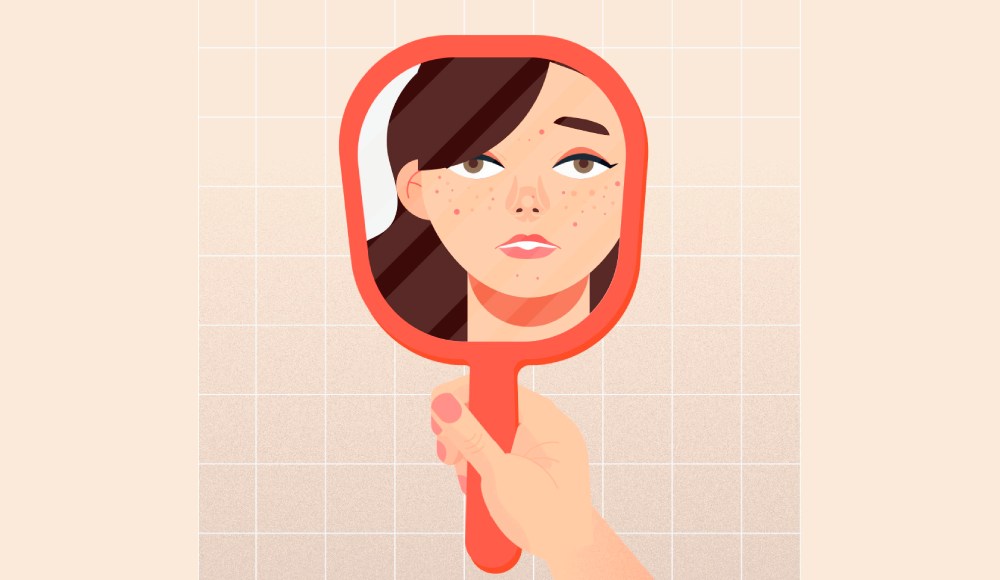We often hear the statement that the mind and body are interconnected. Changes in the body can also result in changes in the mind. The brain and the skin also originate from the same layer of the cell- the ectoderm. Recent research also highlights the comorbidities of psychiatric conditions in patients with dermatological conditions. The field of psycho-dermatology studies the relationship between the cutaneous and psychiatric symptomology. Jafferany et al.,(2020) have found a bi-directional relationship between psychiatric and dermatological symptoms.
How do Dermatological Symptoms manifest?
The simplest form of symptomology is somatisation in which patients may develop medically unexplained symptoms of burning, pain or other physical sensations. Such individuals are more likely to develop a preoccupation with one’s skin and spend excessive time and energy worrying about it. Further it has been found that patients can present with either: a) a primary psychiatric disorder such as dermatitis artefacta (a condition in which client’s deliberately create lesions on their skin/ hair/ nails to harm self); b) a primary dermatological condition which presents with secondary psycho-social comorbidities such as a patient with acne may also present with a low self-esteem (Hoshtotha, 2016).
Psycho-social causes of Dermatological symptoms and comorbidities
A history of psychological trauma, anxious attachment between the child and the parents have been associated with conditions such as dermatitis (Millington,2008). Genetics combined with adverse environmental experiences can exacerbate the pain. As a result, they also lead to several comorbidities such as: symptoms of vitiligo or scars can result in body-image related issues. Research on psoriasis shows it’s impact on one’s health related quality of life. Five dimensions of the stigma associated with psoriasis have been identified: Anticipation of rejection, feelings of being flawed, sensitivity to the attitudes of society, guilt and shame and need to be secretive about the symptoms (Ginsburg & Link, 1989).
In cases of vitiligo, acne it has been found that due to changes in the individuals appearance they are likely to avoid social interactions due to the fear of not meeting the expected standards for appearance.
As a result individuals with psoriasis are likely to present with comorbid depression and low self- image (Hong,2008). It has been found that many dermatological conditions have no cure rather need to be managed. As a result it creates feelings of helplessness and may also impact treatment adherence over a period. Hence working with the client’s physical symptoms and psychological distress is equally important.
Psychological Interventions for Dermatological conditions
Several researches have been conducted on psychological interventions for dermatological conditions. Due to the nature of the conditions, they have been associated with features of chronicity, pain and a sense of hopelessness. There is clear evidence suggesting the benefit of cognitive behaviour therapy for dermatological conditions as it helps address the negative thought patterns, the underlying emotions and also bringing about behavioural changes (Eg- managing repetitive checking, skin picking, etc) and replacing them with more adaptive patterns of behaviour.
Role of Mindfulness based Interventions
Research has also highlighted the importance of mindfulness -based therapies for dermatological patients. Mindfulness has been referred to as present moment awareness. It involves attending in an open, accepting, and discerning way to whatever is arising in the present moment. The practice of mindfulness was originally aimed to manage stress but overtime it showed results with other conditions such as diabetes, dermatological conditions, pain and immune disorders. Research has found benefits of mindfulness based interventions to help manage the depression and anxiety related symptoms associated with skin related conditions(Montgomery et al.,2016). The use of self- compassion based interventions have also proven effective in improving levels of adjustment and also in managing the levels of depression and anxiety (Meneo,2022). Further compassion focused interventions have also proven helpful in managing feelings of shame associated with one’s body image. Overall mindfulness has proven beneficial as they directly work with the client’s self- esteem and also helps with the subjective experience of pain. Additionally it has also helped in improving skin anxiety and also overall levels of dermatological quality of life.
References
Ginsburg, I. H., & Link, B. G. (1989). Feelings of stigmatization in patients with psoriasis. Journal of the American Academy of Dermatology,20(1), 53-63.
Lakum, M. (2024). The Hidden Struggle: Understanding the Psychosocial Impact of Dermatological Diseases. Indian Journal of Postgraduate Dermatology,2(2), 74-79.
Montgomery, K., & Thompson, A. R. (2018). The potential role of mindfulness in psychosocial support for dermatology patients. Clinics in Dermatology, 36(6), 743-747
Narang, Tarun; Kumaran, MSendhil; Yadav, Savita . (2013). Psychodermatology: A comprehensive review. Indian Journal of Dermatology, Venereology, and Leprology, 79(2), 176
Shenoi, S. D., & Prabhu, S. S. (2018). Psychodermatology: An Indian perspective. Clinics in dermatology, 36(6), 737–742
Simons, R. E., Zevy, D. L., & Jafferany, M. (2020). Psychodermatology of vitiligo: Psychological impact and consequences. Dermatologic Therapy, 33(3), e13418.

